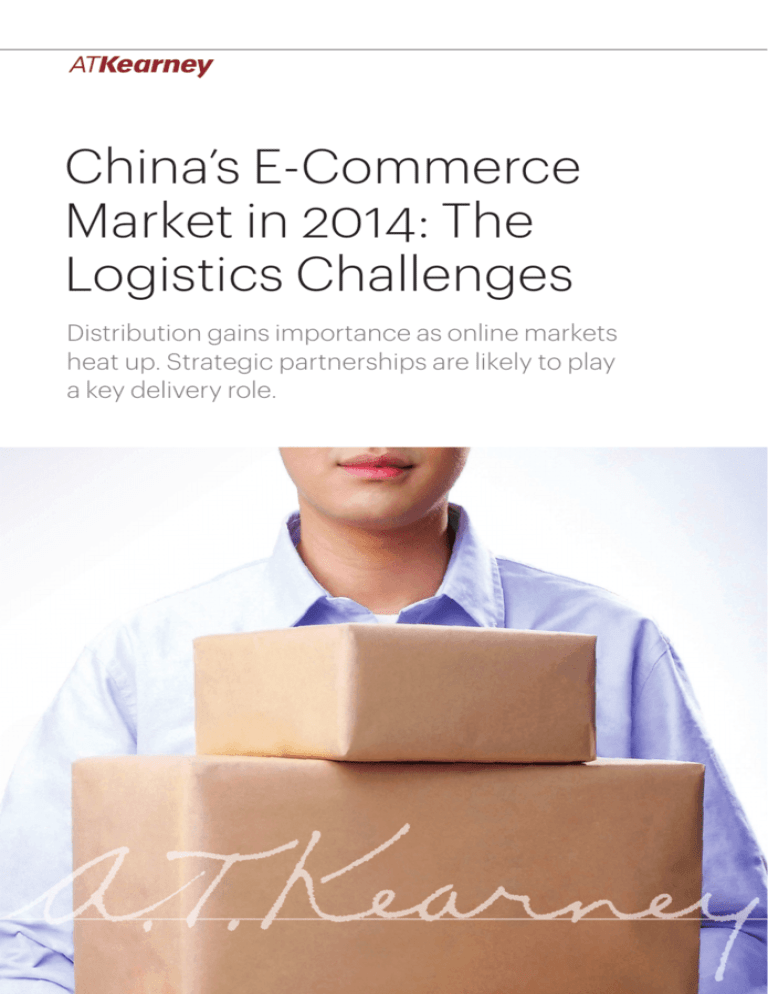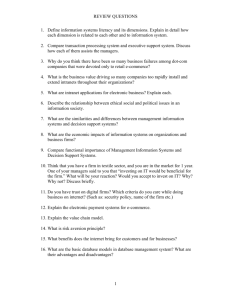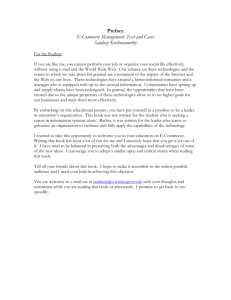
China’s E-Commerce
Market in 2014: The
Logistics Challenges
Distribution gains importance as online markets
heat up. Strategic partnerships are likely to play
a key delivery role.
China’s E-Commerce Market in 2014: The Logistics Challenges
1
In barely five years, China’s e-commerce market—which makes up almost 90 percent of its
overall business-to-consumer (B2C) market—has become a formidable force. Online shopping
has expanded at a CAGR of 70 percent over the past five years, rising from roughly $21 billion in
2008 to nearly $300 billion in 2013 (see figure 1).1
Success in this rapidly growing market
is not a given. Managing logistics may
be the main differentiator as the online
market heats up.
However, success in this rapidly growing market is not a given. In particular, logistics will be
a challenge as e-commerce players attempt to reach more customers over wider geographic
regions while improving the quality of their offerings. The growth of domestic express
delivery—most directly tied to e-commerce—is lagging the exponential growth of e-commerce
in China, raising concerns about how well logistics players can handle ever-increasing volumes.
In fact, managing logistics may be the main differentiator as the online market heats up—along
with other B2C segments, such as TV-based and mail-order shopping. We researched the
e-commerce industry to determine how major players are tackling the logistics issue. This
paper highlights our findings.
Figure 1
Online shopping will continue to grow in China, though more modestly
E-commerce market size
($ billion)
718
Business to consumer
+25%
Consumer to consumer
611
503
390
297
+70%
21
42
3
21 0
39
2008
2009
74
10
64
2010
210
110
148
2011
2012
227
158
107
62
16
94
378
303
189
232
2013
2014f
276
308
339
2015f
2016f
2017f
Note: Exchange rate is 6.2 yuan per dollar. Totals may not resolve due to rounding.
Sources: iResearch, Analysys International; A.T. Kearney analysis
All monetary amounts are U.S. dollars; growth rates are compound annual growth rates.
1
China’s E-Commerce Market in 2014: The Logistics Challenges
1
Trends in E-Commerce
Amid the rapid growth in China’s e-commerce market, several trends are shaping the nearterm landscape.
Rise in access channels
An estimated 300 million people shop online in China. Today, more than half of China’s Internet
users access the Internet with their mobile phones. Mobile shopping is a growing trend that we
expect will continue to grow. Indeed, the share of mobile shopping in China’s online shopping
market rose from 1.5 percent in 2011 to 9.2 percent in 2013, and we foresee a 20 percent annual
growth rate in the near future (see sidebar: Who? What? Why? China and the Online (R)evolution
on page 3).
Increase in B2C business
China’s e-commerce market is dominated by the consumer-to-consumer (C2C) industry,
accounting for 64 percent of the market in 2013 and driven primarily by Taobao’s early
successes.2 However, B2C is gaining momentum, driven by the rapid growth of B2C marketplaces, and is expected to reach 53 percent of the market in 2017. As C2C shoppers gain
e-commerce experience, they are moving to B2C sites in a quest for higher-quality products
and services (see sidebar: B2C on Your Laptop on page 4). And as C2C sellers become more
established, they are launching their own B2C sites.
More geographic spread
Geographic growth in online shopping is becoming a vital issue for the e-commerce industry.
Today’s consumer market is concentrated in regions, with the top 10 cities (in terms of Taobao
usage) located on the coast (see figure 2). However, the number of online shoppers is growing
Figure 2
E-commerce is popular in China’s coastal cities
Online shopping index
(scale of 0 to 100, 2013)
50.2
Shenzhen
46.4
46.0
Hangzhou Guangzhou
43.0
Zhuhai
42.9
Beijing
38.6
Xiamen
38.4
Shanghai
35.1
34.1
32.2
Nanjing
Suzhou
Ningbo
Note: The index considers sales per online store, penetration rate of online shoppers, and online shopping value per customer. The score is calculated based
on the online penetration in each city (number of online consumers over the age of 18) and average online spending per consumer (average online spending
over average disposable income per consumer).
Sources: AliResearch; A.T. Kearney analysis
Taobao is China’s biggest online marketplace.
2
China’s E-Commerce Market in 2014: The Logistics Challenges
2
fastest in lower-tier cities (see figure 3). This trend is expected to continue as wealth in the
inland cities increases. As overall geographic coverage expands, the ability to offer reliable
and consistent services and delivery will be among the biggest challenges—and a major
source of competitive advantage.
Figure 3
Online shopping is growing fastest in China’s lower-tier cities
Growth in number of first-time online shoppers
(first half of 2012 vs. first half of 2011, %)
150.6
106.6
39.9
20.7
Tier 1
15.2
Tier 2
21.7
Tier 3
Tier 4
Tier 5
Tier 6
Sources: China E-Commerce Research Center; A.T. Kearney analysis
Who? What? Why? China and the Online (R)evolution
E-commerce has experienced
exponential growth in China
since the mid-2000s, when it
was just a blip on the retail radar
screen. Three factors have
spurred this online evolution:
age 30 was about 33 percent
in 2013. According to Shanghaibased iResearch, almost 300
million people shop online in
China, most between age 18 and
35, with men shopping slightly
more than women.
More online shoppers
China has 600 million Internet
users—after 53 million new
users connected in 2013. Yet
this number is still low when
considering Internet penetration rates: China’s current
Internet penetration rate is
46 percent, compared to 83
percent in the United States.
But China’s Internet users are
spending more time online,
averaging 25 hours per week.
The ratio of online users over
More purchasing power
China’s economic affluence
has increased significantly
in the past decade. Personal
disposal income per capita
reached $3,000 in 2013 and is
expected to rise by 11 percent
to more than $5,000 in 2018.
The percentage of households
earning more than $3,000
per year is also rising, from
69 percent in 2013 to an
estimated 75 percent in 2018.
More online security
When Web 2.0 arrived,
e-commerce sites in China began
tracking and publishing credibility records of online sellers,
reducing the risk of fraud. This
has helped e-commerce
overcome perhaps its biggest
psychological barrier. Reliable
payment methods, such as
collection on delivery and Alipay,
are also making online transactions more convenient and
trustworthy. “Seeing is believing”
still rings true for most Chinese
consumers, and these payment
methods allow them to see
products before paying for them,
thus increasing the number
of transactions.
China’s E-Commerce Market in 2014: The Logistics Challenges
3
Fixing Logistics: Three Proven Strategies
The relative scarcity of high-quality logistics providers in China often means problems for
e-commerce firms: late deliveries, damaged and lost parcels, negative attitudes from delivery
people, slow collect-on-delivery (COD) processes, poor return procedures, and no special
services such as installation or the ability to try on purchases. Such last-mile delivery and
customer interface issues inevitably affect the credibility and brand image of e-commerce firms.
Furthermore, e-commerce leaders in certain industries—including baby goods, consumer
electronics, telecommunications, computer products, and furniture—are struggling with
logistics suppliers’ inability to handle large or irregularly shaped shipments at lower costs.
Few domestic express companies are equipped to handle freight, and freight companies
cannot provide door-to-door service.
Faced with these and other challenges, we recommend three time-tested and proven strategies
for e-commerce firms to address their logistics needs.
B2C on Your Laptop
These are exciting times for
China’s B2C market, thanks
largely to the growth of
e-commerce. How are the different market segments faring?
E-commerce
Almost 90 percent of the B2C
market in China is e-commerce,
which has experienced 70
percent annual growth since
2008. This rapid growth is
expected to continue, with the
e-commerce market possibly
reaching nearly $720 billion by
2017. More than half of that could
be B2C. More than 80 percent of
e-commerce takes place in
online marketplaces, of which
Taobao (similar to eBay) is the
largest. Taobao customers
account for nearly 9 million
transactions a day.
Online stores are expected to
be a big share of the e-commerce
market in the future, even as
adoption rates vary across
industries. Among the largest
e-commerce segments are
apparel, consumer electronics,
and publications (including
books and DVDs)
(see figure).
TV shopping
Mail order
TV-based shopping is the secondlargest B2C segment, with four
player—Acorn, Happigo, OCJ, and
Seven Stars—comprising more
than 50 percent of the market. Yet
TV shopping is still relatively new
to Chinese consumers, and
penetration rates continue to be
low compared with the United
States and Japan. We expect TV
shopping to increase its share
in the coming decade.
Unlike European and North
American markets, mail order
is a small market in China, with
a few pure-play mail-order
companies and some top global
firms (such as Bertelsmann)
that entered in the 1990s and
eventually exited. Existing
players tend to combine online
shopping with mail order, with
the latter serving mostly as a
marketing tool.
Figure
Apparel and consumer electronics dominate e-commerce
in China
Share of online shopping, by value (2013, %)
Others
39
Apparel
27
Consumer electronics
20
Food and beverages
2
Publications
3
Cosmetics
5
Infants and mothers
5
Note: Percentages may not resolve due to rounding.
Sources: iResearch; A.T. Kearney analysis
China’s E-Commerce Market in 2014: The Logistics Challenges
4
Build your own networks
Many large e-commerce players are choosing to build internal logistics networks, incorporating
their own teams into the business model to ensure quality. Some of these companies established
the in-house capabilities at their inception; others did so only after suffering serious bottlenecks
as a result of relying on third-party logistics centers and delivery teams. The improved quality and
resource control have proved worthwhile, both in faster delivery and a better customer experience.
Building a logistics arm is not for every
company—only those with large volumes
and efficiencies.
For example, Jingdong (formerly 360buy) posted a 300 percent growth rate in the first five
years after logistics bottlenecks forced the company to establish its own express delivery
operation in 2009. With its own network, Jingdong can provide same- or next-day deliveries
from its seven distribution centers. Jingdong has 97 warehouses in 39 cities, covering 1.8 million
square meters, and processed 320 million orders in 2013.
Building a logistics arm is not for every company—only those with large volumes and
efficiencies, especially in last-mile delivery, which often accounts for half of total logistics
costs. For example, in a project we worked on a few years ago, we found that with fewer than
500 deliveries per day in a city, deploying a company-owned delivery team could cost 15 yuan
($2.20) or more per parcel, eating away at profits. This cost could drop to less than two yuan
($.30) per parcel with more than 10,000 deliveries per day in a city (see figure 4). As such, it is
doubtful that even the largest e-commerce players can fully address the demand internally
and profitably, considering the wide geographic spread of the market. Leading companies
understand if and where to deploy their own logistics capabilities.
Figure 4
Company-owned delivery can eat away at small players’ profits
40
35
Owned
Outsourced
30
Last-mile
delivery cost
(average cost
per parcels, yuan)
25
20
15
10
5
0
0
1,000
2,000
3,000
4,000
5,000
6,000
7,000
8,000
9,000
10,000
Total parcels delivered
(per city per day)
Source: A.T. Kearney analysis
China’s E-Commerce Market in 2014: The Logistics Challenges
5
Outsource to third-party providers
Given the lack of scale and capabilities, most e-commerce companies still outsource delivery
to third-party express companies. Most express delivery providers in China can be grouped
into two types:
Large networks offering basic services. Firms in this group typically have large network
coverage but can provide only basic delivery services. Most rely on franchised models to expand
rapidly (only 20 to 40 percent are self-owned) and compete chiefly on speed and price. Network
coverage is wide, especially with backup from the state postal service for remote areas.
These large networks do not offer more complex services such as scheduled returns,
exchanges, or COD. Given their franchised or subcontracted models, there are also inherent
risks. For example, most players offer a one- or two-week COD repayment cycle, exposing
e-commerce companies to a significant amount of risk. Ensuring the integrity and viability
of the entity collecting the cash is a crucial element to consider.
Many logistics companies are investing
heavily to broaden their capabilities
and fill the clear gap in the market.
One exception is Shunfeng Express, the largest private express company in China, with more
than 7,800 locations in mainland China, 9,100 locations globally, and reliable and fast service.
Shunfeng maintains a premium position in the market, but its standardized services are not for
everyone. China Post’s EMS, with more than 45,000 locations around the world, has the largest
network, but speed and reliability continue to be issues.
Smaller networks offering more complex services. These typically fully owned companies
have smaller network coverage—some, such as Topname, compete only regionally—and their
focus on regional services enables full-fledged value-added services such as warehousing,
COD, and customized delivery. These companies are selective about where they expand
their networks, choosing cities only if there is enough volume, and they focus mainly on
the B2C market.
International companies such as FedEx and TNT also fall into this category. They have more
limited networks than the domestic players but offer a broader range of services and are more
reliable and consistent. Other providers, such as Kerry EAS, also serve the B2C market, with
strengths in warehouse pick-and-pack operations rather than delivery.
There is a clear gap in the market, with no player offering the breadth of services needed at
a competitive price across a broad network demanded by e-commerce companies. However,
many logistics companies are investing heavily to broaden their capabilities to fill this gap,
particularly in line haul and last-mile deliveries. Warehouse pick-and-pack, which could
represent 40 percent of total logistics cost of a parcel (and is a manual operation today),
is another opportunity. When sizing up a potential third-party logistics provider, it is important
to look not only at its current capabilities but also at its growth and investment plans.
China’s E-Commerce Market in 2014: The Logistics Challenges
6
Form partnerships or acquire existing firms
A third approach is to invest in existing logistics companies or form partnerships with them.
Alibaba, the e-commerce giant that owns Taobao, invested $4.5 million in Star Express.
Alibaba’s founder, Ma Yun, also invested in Best Logistics, which subsequently acquired
a 70 percent stake in HTO; Star Express and HTO are the major Chinese express delivery
companies. However, given Taobao’s size (eight million shipments a day), no logistics player
or acquisition alone will meet its speed and service requirements. As such, Alibaba partnered
with Shunfeng Express, Yuantong, Shengtong, Zhongtong, and Yunda in 2013 to establish
a logistics platform called Cainiao. Their target is to build within five to eight years a national
logistics network that can deliver to anywhere in China within 24 hours. Alibaba also acquired
a 10.8 percent stake in Singapore Post in May 2014 to further expand its international network.
Logistics: The Key to E-success
The rapid growth of e-commerce and the subsequent logistics challenges mean e-commerce
companies and logistics providers both have an opportunity to move quickly to address their
problems. The solutions are unlikely to come from e-commerce in-house logistics since market
growth will soon make these unsustainable. Real solutions are more likely to be found in
strategic partnerships between e-commerce firms and third-party logistics providers. Indeed,
within a few years, we expect to see a transformation in China’s e-commerce logistics
landscape, where e-commerce plus logistics providers will equal market success.
Authors
Mui-Fong Goh, partner, Singapore
mui-fong.goh@atkearney.com
Chee Wee Gan, principal, Shanghai
cheewee.gan@atkearney.com
China’s E-Commerce Market in 2014: The Logistics Challenges
7
A.T. Kearney is a leading global management consulting firm with offices in more
than 40 countries. Since 1926, we have been trusted advisors to the world's foremost
organizations. A.T. Kearney is a partner-owned firm, committed to helping clients
achieve immediate impact and growing advantage on their most mission-critical
issues. For more information, visit www.atkearney.com.
Americas
Atlanta
Bogotá
Calgary
Chicago
Dallas
Detroit
Houston
Mexico City
New York
Palo Alto
San Francisco
São Paulo
Toronto
Washington, D.C.
Asia Pacific
Bangkok
Beijing
Hong Kong
Jakarta
Kuala Lumpur
Melbourne
Mumbai
New Delhi
Seoul
Shanghai
Singapore
Sydney
Tokyo
Europe
Amsterdam
Berlin
Brussels
Bucharest
Budapest
Copenhagen
Düsseldorf
Frankfurt
Helsinki
Istanbul
Kiev
Lisbon
Ljubljana
London
Madrid
Milan
Moscow
Munich
Oslo
Paris
Prague
Rome
Stockholm
Stuttgart
Vienna
Warsaw
Zurich
Middle East
and Africa
Abu Dhabi
Doha
Dubai
Johannesburg
Manama
Riyadh
For more information, permission to reprint or translate this work, and all other
correspondence, please email: insight@atkearney.com.
The signature of our namesake and founder, Andrew Thomas Kearney, on the cover
of this document represents our pledge to live the values he instilled in our firm and
uphold his commitment to ensuring “essential rightness” in all that we do.
A.T. Kearney Korea LLC is a separate and independent legal entity operating under the A.T. Kearney name in Korea.
A.T. Kearney operates in India as A.T. Kearney Limited (Branch Office), a branch office of A.T. Kearney Limited,
a company organized under the laws of England and Wales.
© 2014, A.T. Kearney, Inc. All rights reserved.










